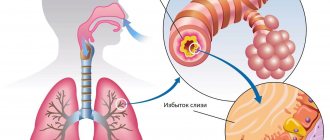Chronic bronchitis is a disease characterized by excess sputum production and cough for at least 3 months per year for at least 2 consecutive years1. Chronic bronchitis can accompany many chronic bronchopulmonary diseases, such as bronchiectasis, but the main and most common cause of chronic bronchitis is smoking. In addition to chronic bronchitis, smoking causes acute respiratory diseases, including pneumonia in individuals who do not have underlying chronic obstructive pulmonary diseases; impaired lung development in childhood and adolescence; early onset of deterioration in lung function (at the late stage of puberty and early puberty); premature onset and accelerated age-related decline in respiratory indicators of pulmonary function in children and adolescents; including cough, sputum, wheezing and shortness of breath; asthmatic symptoms (ie wheezing) in childhood and adolescence; illness and death from chronic obstructive pulmonary disease (COPD)2. Currently, the term “smoker’s bronchitis” has practically been replaced by the term “chronic obstructive pulmonary disease”3.
Main symptoms
The main symptoms of chronic bronchitis are cough with expectoration of sputum. In addition, distant wheezing, heaviness and congestion in the chest, and shortness of breath during exercise may appear. People who smoke often have a cough with sputum all year round, and against this background, exacerbations of bronchitis periodically develop3.
Initially, cough occurs mainly in the autumn-winter period, significantly decreasing or completely disappearing in the warm season. In the absence of treatment, the cough progresses over the years and becomes year-round, exacerbations with the appearance of purulent sputum occur more often, last longer and are more severe, and shortness of breath gradually develops during physical exertion.
During exacerbations, the cough usually intensifies, the volume of sputum increases, although in the first days it may decrease; At the same time, coughing becomes difficult. During an exacerbation, the color of sputum often changes to darker: yellow, green or brown. Exacerbations of bronchitis may be accompanied by shortness of breath on exertion or a feeling of chest congestion or heaviness, even in those patients who do not experience such sensations in a stable condition4.
Signs of a smoker's cough
This is a persistent dry or wet cough with a characteristic hoarse sound. Attacks usually appear in the morning, pass within a few hours, but sometimes make themselves felt throughout the day. This is due to the fact that it is easier for the bronchi to free themselves from thickened secretions in an upright position of the body.
After the first cigarette smoked in the morning, the cough may subside or become more bothersome. Changing your usual brand of cigarettes or abruptly giving up cigarettes can also cause a temporary increase in cough.
Other causes of chronic cough
Pathogenesis
Smoking disrupts the functioning of the cilia that cover the inner lining of the bronchi (bronchial epithelium) and causes excessive mucus formation in the bronchial wall, and it does not matter what exactly the patient smokes: pipe tobacco, cigarettes or marijuana. Thus, under the influence of tobacco smoke components, non-infectious inflammation develops in the bronchi. In addition, nicotine causes spasm of the muscular lining of the bronchi (bronchospasm). These processes are expressed in the appearance of a cough with phlegm, and sometimes shortness of breath or a feeling of chest congestion or “heavy breathing.” The accumulation of sputum in the bronchi can cause distant wheezing, which the patient hears himself when inhaling or exhaling4.
Similar changes in the bronchial tree can occur not only with smoking, but also with prolonged exposure to other unfavorable factors: long-term inhalation of industrial smoke, for example, during welding, soldering, contact with combustion products, etc.5, therefore, before making a diagnosis, a detailed conversation between the doctor and the patient to find out all the possible causes of bronchitis.
Does e-cigarettes cause coughing?
Electronic cigarettes, mini-hookahs and other devices for inhaling steam (vapes) have emerged as an alternative to conventional cigarettes, which were initially declared to be safe. However, later the thesis about the safety of vaping was refuted by scientists who found that inhaling vapor with impurities, including those not containing nicotine, negatively affects the respiratory system. The condition has received an official name - “e-cigarette use-associated lung injury” (English acronym: EVALI).
Why do electronic cigarettes cause coughing? Vapor from e-cigarettes also contains dangerous chemicals, although in lower concentrations than tobacco smoke. But these substances, just like the combustion products of tobacco, irritate the respiratory tract and provoke inflammation, which leads to difficulty breathing and coughing. In addition, flavorings and propylene glycol in vapes can cause an allergic reaction, which will be accompanied by coughing.
Classification and stages of disease development
Smoker's bronchitis can be divided into simple chronic bronchitis, mucopurulent bronchitis or bronchitis with obstruction, that is, with a narrowing of the lumen of the bronchi (chronic obstructive bronchitis). Smoking patients with chronic obstructive bronchitis are usually diagnosed with chronic obstructive pulmonary disease (COPD)6.
With simple bronchitis, the patient coughs up a small amount of light-colored sputum, and this type of bronchitis in most cases does not affect the patient’s quality of life, that is, it does not cause any discomfort. Such patients do not consider themselves sick and, as a rule, do not go to doctors. With mucopurulent bronchitis of a smoker, the amount of sputum is greater, and it has a yellowish-greenish color, which indicates the addition of a bronchial infection. Chronic obstructive bronchitis is characterized, in addition to coughing with sputum, distant wheezing, shortness of breath or other discomfort associated with breathing. In most cases, shortness of breath limits the patient’s physical activity and gradually increases over the years, that is, it appears with less physical activity, which becomes a reason to seek medical help. This condition requires differentiation from bronchial asthma4.
Bronchial obstruction can have varying degrees of severity, which is determined by studying the function of external respiration - spirometry. Depending on the degree of reduction in the speed of exhaled air, 5 degrees of severity of bronchial obstruction are distinguished: mild, moderate, moderate, severe and very severe7.
To determine the treatment and prognosis of the further course of bronchitis, the frequency of exacerbations is of great importance; if there are more than 2 episodes of exacerbations per year, exacerbations are regarded as frequent, which requires more active treatment8.
Chronic bronchitis of a smoker may also be accompanied by certain features of bronchial asthma; in this case they talk about the syndrome of intersection of chronic bronchitis and bronchial asthma. Chronic bronchitis of a smoker may be accompanied by damage to the lung tissue in the form of its destruction by components of tobacco smoke; this is called emphysema9.
Complications . In general, complications develop in approximately 10% of patients with smoker's bronchitis. Infectious exacerbations of chronic bronchitis can be complicated by the development of pneumonia (in 5% of cases). Rarely, patients with bronchitis experience hemoptysis, more often with exacerbation of bronchitis or pneumonia.
With a long-term course, smoker's chronic obstructive bronchitis (COPD) can be complicated by the development of chronic respiratory failure or pulmonary hypertension (increased pressure in the pulmonary vessels). In addition to complications associated directly with the bronchopulmonary system, chronic obstructive bronchitis can cause extrapulmonary complications, such as osteoporosis, depression, muscular dystrophy, and aggravate the course of coronary heart disease and gastroesophageal reflux disease. Chronic bronchitis of a smoker is a risk factor for the development of lung cancer and other localizations3.
Diagnostics . Diagnosis of smoker's bronchitis, like any other disease, begins with questioning and examining the patient by a doctor. It is important to find out the patient’s living and working conditions, the conditions of onset of the disease, the frequency of exacerbations, previous treatment and the dynamics of the patient’s condition during the illness. A mandatory study for smoker's bronchitis is a study of the function of external respiration - spirometry with a bronchodilation test, which allows you to determine the presence and severity of bronchial obstruction, as well as its reversibility3. Often, when first evaluating a patient with smoker's bronchitis, a chest x-ray is required to rule out emphysema or other structural changes in the lungs and bronchi associated with smoking3. A general sputum analysis can also provide useful information4.
When first examining a patient with smoker’s bronchitis, it is necessary to exclude other bronchopulmonary diseases with similar manifestations: bronchial asthma, bronchiectasis, COPD, cough associated with gastroesophageal reflux (GER), chronic rhinosinusitis4. Differential diagnosis also begins with a detailed analysis of the patient's medical history and life history. All these diseases are manifested by a cough with or without sputum, sometimes the cough is accompanied by shortness of breath during physical exertion, for example, in patients with bronchial asthma or bronchiectasis4.
If necessary, special tests are performed, for example, bronchoprovocation tests to exclude bronchial asthma, computed tomography of the lungs to exclude bronchiectasis and emphysema as manifestations of COPD, gastroscopy, consultation with an ENT doctor. Often, a patient with smoker's bronchitis may have GER, rhinosinusitis, and overlap syndrome with bronchial asthma.
During an exacerbation of bronchitis, as with any acute infectious disease, a clinical blood test, a general sputum test is performed to assess the severity of the inflammatory process in the bronchi, markers of inflammation in the blood (C-reactive protein, sometimes procalcitonin), sometimes a bacteriological analysis of sputum to determine the specific the type of infection that caused the exacerbation of bronchitis, and an x-ray of the lungs to exclude pneumonia4.
Treatment. The main condition for successful treatment of smoker's bronchitis is smoking cessation. For this purpose, nicotine replacement drugs (medical nicotine) and other drugs that reduce the craving for smoking are used10.
Smoker's bronchitis requires long-term treatment throughout the entire period while the patient continues to smoke, and for some time after complete cessation of smoking, since long-term smoking leads to persistent changes in the structure and function of the bronchi, which are difficult to correct and sometimes do not disappear completely even during treatment. The basis of long-term therapy for smoker's bronchitis is inhalers, which dilate the bronchi, reduce the volume of mucus produced and make it easier to cough up. Modern pulmonology has a wide variety of inhaled drugs. For each patient, the doctor selects individual therapy depending on his condition and the characteristics of the course of bronchitis. In addition, agents are used that dilute mucus and facilitate its removal from the bronchial tree11.
In general, treatment is aimed at reducing the severity of symptoms of the disease. Continued smoking or contact with smoke, dust or other adverse external influences reduces the effectiveness of treatment. To reduce the frequency of infectious exacerbations, including the frequency of pneumonia, anti-influenza and anti-pneumococcal vaccination are recommended. Influenza vaccination is carried out annually in early autumn. Anti-pneumococcal vaccination is carried out with two vaccines: a polyvalent conjugate vaccine (PCV-13) and then, no earlier than 1 year later, a polyvalent polysaccharide vaccine (PPV-23)12.
Why is COPD dangerous?
An advanced disease leads to serious consequences, including pulmonary emphysema - when the alveoli become overstretched and lose their ability to contract, as a result of which the supply of oxygen to the blood and the removal of carbon dioxide from it is disrupted.
Bronchiectasis may occur - chronic dilatation of the bronchi with a tendency to suppuration. Patients with COPD are more likely to be hospitalized with thromboembolism, a blockage of the pulmonary artery or its branches by blood clots. They often experience the so-called cor pulmonale - enlargement and expansion of the right chambers of the heart as a result of increased blood pressure in the pulmonary circulation.
Treatment of exacerbations
For exacerbation of bronchitis, antibiotics, inhaled bronchodilators, expectorants and sputum thinners (mucolytics), and antitussives are used. If inhalation and mucolytic therapy was used regularly as a basic therapy, then with exacerbation of bronchitis it usually intensifies.
For severe dry cough that disrupts sleep and daytime activity, antitussive medications are recommended. They are usually prescribed during the initial period of treatment for faster cough relief. Modern antitussive drugs have a fairly weak effect and even in the presence of a small amount of sputum in adult patients they cannot have a negative effect on coughing up, therefore, if necessary, antitussive drugs can be combined with expectorants and sputum-thinning drugs13.
Expectorants and phlegm thinners (mucolytics) can be used in different forms: either as tablets, capsules or syrups, or as inhalations through a nebulizer. Inhalations have their advantages over tablet forms, since during inhalation the medicine enters directly into the respiratory tract, creating a high concentration in them, while the risk of side effects is reduced, since the medicine does not pass through the stomach, liver, kidneys and other organs.
Antibiotics are not always needed during exacerbation of bronchitis, since not all exacerbations are of an infectious nature. Antibiotics are preferred in older people with serious concomitant diseases, such as diabetes mellitus, chronic heart failure, etc., as well as in patients who are often (more than twice a year) treated in hospitals, regardless of the reason for hospitalization, or who are constantly taking medications , which suppress the immune system (immunosuppressants).
In exacerbations of chronic bronchitis, antibiotics are recommended when shortness of breath increases along with the appearance of yellow or green (purulent) sputum14.
With frequent (more than two episodes per year) exacerbations of bronchitis, some types of mucolytics, for example N-acetylcysteine or carbocysteine, can be taken for a long time - up to 1 year, especially in winter, since data have been obtained that in patients with chronic bronchitis, these drugs, when used for a long time, can reduce the risk of exacerbations15.
Forecast. With timely cessation of smoking and initiation of therapy, the prognosis of patients with smoker’s bronchitis is favorable2. In later stages of the disease, in patients with chronic obstructive pulmonary disease, the main task of the doctor is not so much improvement (which is not always achievable), but rather inhibition of disease progression and prevention of serious exacerbations and the development of chronic respiratory failure4.
Prevention. An important component of the prevention of smoker's bronchitis is patient education, that is, conversations about the negative consequences of smoking, the need to quit smoking, and eliminating contact with other adverse environmental factors, including occupational factors; about vaccination, about the prevention of exacerbations of bronchitis, etc. 3.5
Bibliography
- Global Initiative for Chronic Obstructive Lung Disease. Global strategy for the diagnosis, management, and prevention of chronic obstructive pulmonary disease. Bethesda, MD, USA: GOLD, 2013.
- Respiratory medicine: manual: in 3 volumes / ed. A. G. Chuchalina. — 2nd ed., revised. and additional M.: Litterra, 2021. T. 1. P. 543.
- Global Initiative for Chronic Obstructive Lung Disease. Global strategy for the diagnosis, management, and prevention of chronic obstructive pulmonary disease. Bethesda, MD, USA: GOLD, 2010.
- Global Initiative for Chronic Obstructive Lung Disease. Global strategy for the diagnosis, management, and prevention of chronic obstructive pulmonary disease. Bethesda, MD, USA: GOLD, 2021.
- Chuchalin A.G., Aisanov Z.R., Chikina S.Yu. and others. Federal clinical recommendations of the Russian Respiratory Society on the use of spirometry. Pulmonology. 2014; 6:11–23.
- Chuchalin A.G., Aisanov Z.R., Avdeev S.N. and others. Russian Respiratory Society. Federal clinical guidelines for the diagnosis and treatment of chronic obstructive pulmonary disease. M.: RRO; 2014
- Sukhovskaya O.A. A practical algorithm for quitting smoking. Practical pulmonology. 2021. No. 2. pp. 30-32.
- Chikina S.Yu. Mucolytics: current role in the management of patients with chronic obstructive pulmonary disease. // Practical pulmonology. 2015. No. 4. pp. 18-22.
- Chuchalin A.G., Briko N.I., Avdeev S.N. and others. Federal clinical recommendations for vaccine prevention of pneumococcal infection in adults. Pulmonology 2021. T. 29. No. 1. pp. 19-34. DOI: 10.18093/0869-0189-2019-29-1-19-34.
- Bolser DC Cough suppressant and pharmacologicprotussive therapy. Chest 2006;129; 238S-249S. DOI 10.1378/chest.129.1_suppl.238S.
- Stey C., Steurer J., Bachmann S. et al. The effect of oral N-acetylcysteine in chronic bronchitis: a quantitative systematic review. Eur. Respira. J. 2000; 16:253–262.
How is COPD treated?
Like any chronic disease, COPD is incurable. It is only possible to maintain bronchial patency with medication, and in case of exacerbation, doctors prescribe anti-inflammatory and antimicrobial therapy.
“With proper therapy, remission is achieved - a state equal to healthy,” says Irina Bakhareva. “But the trouble is that COPD has irreversible consequences, which are completely and forever impossible to get rid of.”
Inhalers are selected for patients. In severe forms of respiratory failure, inhalation of drugs through a nebulizer (nebulizer) and oxygen therapy are prescribed.
If the patient no longer has reserves left for spontaneous breathing, the time comes for palliative therapy, and the person breathes through an oxygen concentrator for the rest of his life. The most extreme treatment option is lung transplantation.
Artificial respiration.
pixabay.com.
Treatment of chronic bronchitis in adults and children in medical
Treatment of acute bronchitis depends on the cause.
- For a bacterial infection, the patient is prescribed antibiotics: systemic drugs (usually in tablet form) or local ones, for example, for inhalation.
- When the disease is viral in nature, it is usually limited to immunostimulants and general adaptogens.
- If the pathology is caused by chemical compounds or individual intolerance to any substances, further contact with toxins or allergens is excluded.
- Symptomatic therapy consists of taking anesthetics, anti-inflammatory drugs, monitoring body temperature and drinking plenty of warm water. Drugs that thin sputum and stimulate its excretion are also widely used.
Treatment of chronic bronchitis outside of exacerbation is a more complex and lengthy task. First, all nearby foci of infection in the patient’s body are identified and eliminated, the oral cavity is sanitized and the immune system is supported. The most important point (especially in children!) is improving airway patency in the obstructive form of the disease. For this, drugs are prescribed that relax the muscles of the bronchi and dilate them, expectorants and mucolytics. Corticosteroids are used to relieve inflammatory reactions. Physiotherapeutic procedures, physical therapy and drainage massage also have a good effect.








